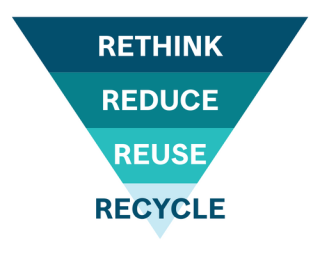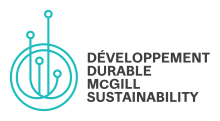Why Zero-Waste?
We all generate waste every day, but we don’t always stop and think about how much waste we generate, where it goes when we are finished with it, and the broader impact it has.
Reducing the number of products we consume and dispose of is an essential part of social, environmental, and economic sustainability.
McGill’s Zero-Waste Knowledge Base is a resource to help you understand the important impact of waste, learn what McGill is doing to become zero-waste and rethink your consumption and waste sorting habits.
Environmental Impact of Waste
Disposing of waste, through dumping in landfills or incineration, contributes to climate change, pollution, and environmental degradation. As materials decompose in landfill, large quantities of carbon dioxide and methane are released into the atmosphere, adding to global warming.
Methane is a powerful and potent greenhouse gas that has 86 times more global warming potential than carbon dioxide over a 20-year period. According to Environment and Climate Change Canada, 23 percent of Canada’s methane emissions come from waste.
What we throw away also has more immediate impacts on the health of our planet and people.
Landfills can lead to the contamination of soil and water through leachate, when rainwater leaches and draws out chemicals and contaminants when in contact with waste. This endangers ecosystems and the health of communities. Sending waste to landfill also creates additional air pollution, which lowers the quality of the air we breathe.
Litter that is not properly disposed of is another large issue that contributes to environmental degradation. Plastic makes up to 90 percent of marine debris and trash which can cause suffocation, starvation, and drowning for marine life.
When plastics break down in the ocean, microplastics, which are plastics under 5 mm in size, are produced and make their way into water and food sources for humans and animals. Not much is known about microplastics and their impacts yet, but it is a growing concern.
Social Impact of Waste
Waste disposal also has important social impacts that should not be ignored.
We know that landfills and incineration of waste can be detrimental to human health through the air, water, and soil pollution, but other negative impacts include noise, smell, and smoke.
There are also environmental justice implications for waste disposal. Property values near landfills are lowered because of these negative impacts. Moreover, landfills are more often located in neighbourhoods with a higher proportion of low-income and minority populations which is an example of environmental racism.
In Canada and elsewhere in the world, Indigenous peoples face the brunt of pollution and are often at the forefront of resistance against it. Environmentally degrading infrastructure projects such as mines, pipelines, and waste incinerators impact Indigenous peoples’ access to clean water and traditional hunting, gathering, and fishing grounds. Consequently, Indigenous people frequently lead legal and advocacy efforts against these projects.
What is Zero-Waste?
The Zero Waste International Alliance defines zero-waste as:
“The conservation of all resources by means of responsible production, consumption, reuse, and recovery of products, packaging, and materials without burning and with no discharges to land, water, or air that threaten the environment or human health.”
Zero-Waste Hierarchy
Zero-waste is not only about sorting your waste properly after using or consuming an item but also about what you buy and how it is produced.
The zero-waste hierarchy is a helpful tool for deciding the best course of action to achieve zero-waste.
The hierarchy is: 
- Rethink
- Reduce
- Reuse
- Recycle
Circular Economy
Zero-waste is closely linked to the concept of a circular economy.
According to United Nations Conference on Trade and Development (UNCTAD), a circular economy is when:
- All forms of waste are returned to the economy, while residual waste is reduced to a minimum,
- The constant extraction of new resources is avoided, and
- The lifetime of products and materials is extended by reuse, repairing, sharing, and recycling.
A circular economy is beneficial because it significantly reduces greenhouse gas emissions and environmental destruction through its reduction of raw material extraction. It can also boost economic growth and create jobs.
Zero-Waste at McGill
Zero-Waste by 2035
 McGill aims to become zero-waste by 2035 by attaining a diversion rate of 90 percent, based on the Zero-Waste Alliance's internationally recognized standard.
McGill aims to become zero-waste by 2035 by attaining a diversion rate of 90 percent, based on the Zero-Waste Alliance's internationally recognized standard.
The Climate & Sustainability Strategy 2025-2030 outlines the University’s waste management goals. These include expanding organic waste collection, reducing single-use items on campus, and replacing outdoor stand-alone landfill bins with multi-stream sorting stations.
Reduce Your Waste
Using the Zero-Waste Hierarchy, here are some steps you can take on campus and beyond to reduce your waste.
Rethink
Waste is a global challenge, but the sustainable choices we make create a positive change. It is up to all McGillians to rethink their consumption and address the waste they produce.
Learn more about zero-waste
Some ways you can learn more about rethinking your consumption on campus include:
- Apply to be a Zero-Waste Ambassador and build a culture of sustainability at McGill by sharing knowledge about waste reduction and diversion, fostering zero-waste and circular economy practices, and encouraging our community to re-think its waste.
- Become a Sustainable Workplace Ambassador and empower your coworkers to create meaningful and sustainable change, such as proper waste management, in their workplace.
- Host a zero-waste event certified through the Sustainable Events Certification program by receiving consultations, training, and resources on best practices for sustainable events, including how to reduce material waste generated on campus.
- Students are encouraged to take Sustainability at McGill: Creating a Brighter Future, while staff can complete Envisioning a More Sustainable McGill to learn more about how to take action on waste.
- Check out the Sustainable Labs Guide, there's a dedicated section on Waste Management.
Reduce
Reduce the quantity of material and resources you consume and discard.
Avoid single-use products
Eliminating single-use items is especially effective when eating on campus because food-related waste and packaging represent a large portion of waste on campus. Try making these zero-waste swaps:
- Bring a reusable mug for your coffee: As part of the Lug-A-Mug program, you'll get a discount on beverages when you bring your reusable drink container to participating locations on campus.
- Bring a reusable water bottle: Thanks to the Refill McGill campaign, McGill no longer sells bottled water on its campuses. Scope out the location of water fountains and taps near where you study or work.
- Carry reusable dishware and cutlery.
- Carry reusable bags.
- Take advantage of reusable dishware programs on campus:
- Take advantage of The Plate Club service provided by SSMU that provides the SSMU cafeteria and events on campus with reusable dishware free of charge
Buy in bulk
Buy in bulk if you can. Avoid individually packaged goods, like snack packs. There are several bulk stores and zero-waste shops in Montreal which encourage you to bring and fill your own containers.
Buy less
Buy only what you need. Avoid buying new things by sharing and swapping items. For example, instead of buying a packaged lunch, try bringing your own. You can warm it up using one of the microwaves on campus.
McGill Little Free Libraries (LFL) are designed for sharing books. Visitors are free to take a book and keep it, or return it when finished to any LFL on campus. LFL users can also provide a book of their own to an existing collection.
Buy smarter/better
When buying take-out or other items, try to avoid buying items wrapped in plastic or with excessive packaging. Prioritize items with minimal or easily recyclable packaging. One great option is the McGill Farmers' Market, which offers local vegetable baskets with minimal packaging every Summer and Fall.
Avoid ordering online too frequently. Online shipments are often overpackaged. To reduce your footprint and plastic waste, walk, bike, or take public transit to buy products in person. See this site for more tips on how to avoid single-use plastics.
Reuse
Use products again, repair them, or repurpose them before replacing them. Give your old things a new life by donating them.
On campus, this could take the form of:
- Reusing notebooks if they have not been filled
- Reusing plastic take-out containers and bags
- Buying refillable items, such as pens
- Repairing your items. The Flat Bike Collective provides an anti-oppressive space for all people to learn how to fix their bikes.
- Donating items you no longer have a use for. McGill has an initiative called the Winter Coat Project, which allows students to recycle winter coats and support students who are not prepared for Canada’s cold winters.
- Partnering with MealCare McGill to take your edible surplus food and deliver it to their food aid partners across Montreal if you are hosting an event on campus.
- Contacting RebutRécup, a carbon neutral collection service, during the spring move-out period to donate usable household articles such as furniture, clothes, books and electronics.
- Visiting Thrift McGill, an exciting sustainability initiative run by Student Housing and Hospitality Services in partnership with the Sustainability Projects Fund (SPF). Recognizing the growing need of our community, all items are available for FREE with a valid McGill ID card. It is a donation-based thrift store serving students and staff alike. Thrift McGill aims at reducing waste by collecting items from student and staff that they no longer have use for. Most items are accepted, though exceptions apply.
Recycle
Finally, when your waste needs to be disposed of, recycle what you can so waste can be reprocessed into new materials or compost organic matter so that it can be decomposed and returned to the soil. 
At McGill, everyday waste is divided into four streams:
- Compost
- Landfill
- Two recycling streams:
- Paper and Cardboard
- Plastics, Glass and Metal (PGM)
Learn more about what goes where at McGill and download the free Ça Va Où app to search how to sort over 1,000 items.
Tips for Waste Sorting
- When in doubt, throw it out. Sorting materials in the wrong stream can lead to contamination of the compost and recycling streams, resulting in the whole bag being sent to the landfill.
- Separate packaging and products that are assembled with different materials. For example, separate lids from containers.
- Before sorting plastic into the yellow recycling stream, check for the triangle symbol on the item. If there is a #1,2,3,4,5 or 7 in the triangle, place the item in the yellow recycling stream. If there is a #6 in the triangle or no number at all, the plastic is not recyclable. Dispose of the item in the landfill stream.
- Food residue can contaminate other products in the recycling bin. Lightly rinse your plastic, glass, and metal containers and aluminum foil before disposing of them in the yellow recycling stream.
- Place materials like empty non-compostable coffee cups in the plastic, glass, and metal recycling stream.
- Only clean and dry paper and cardboard go in the blue recycling stream.
- Paper that has been soiled or become wet can be placed in the brown compost stream, as long as it has not been in contact with chemicals.
- Organic materials go in the brown compost stream. Anything that was once a living organism is considered an organic material, including food waste, paper products, and bamboo utensils.
